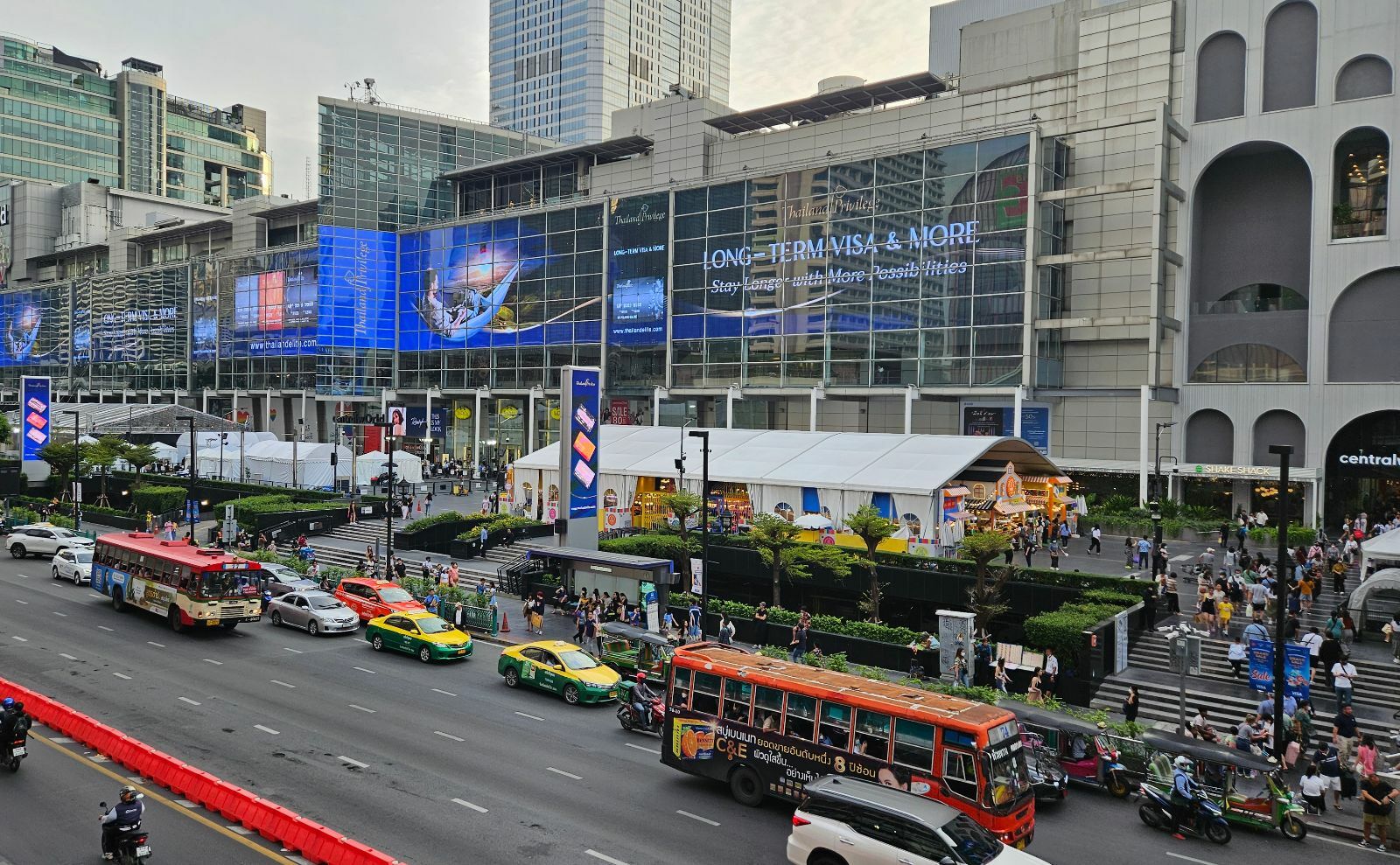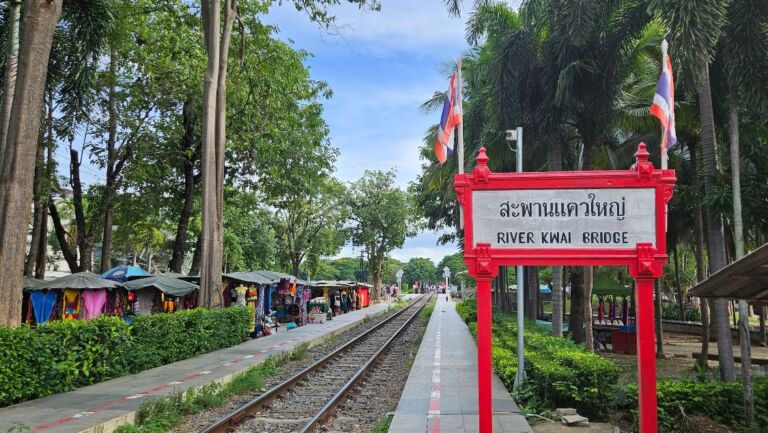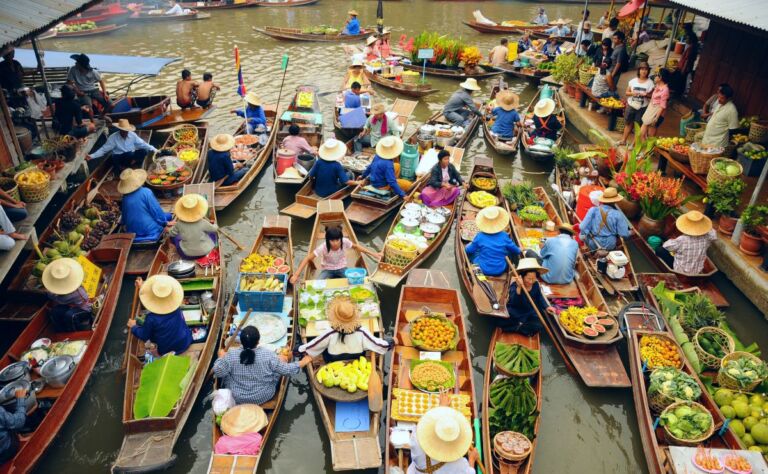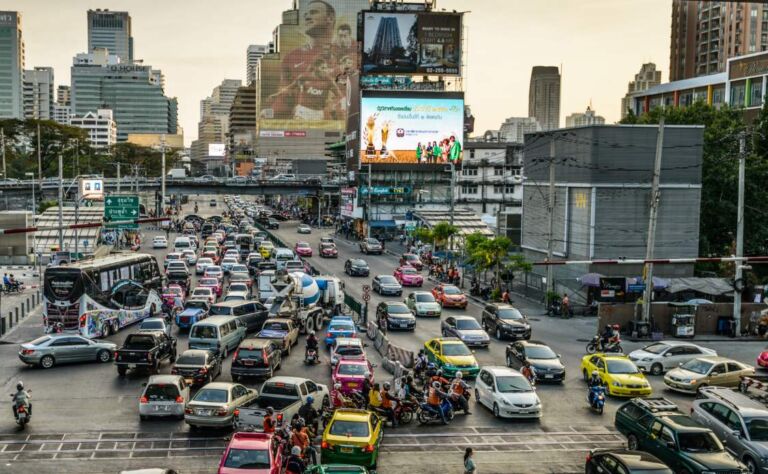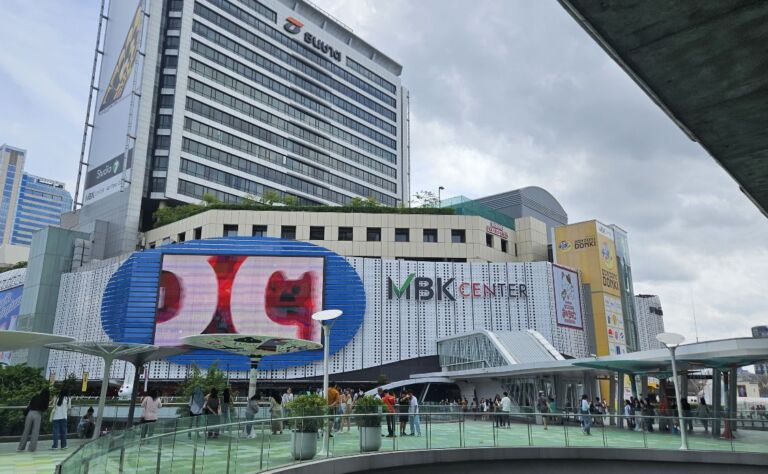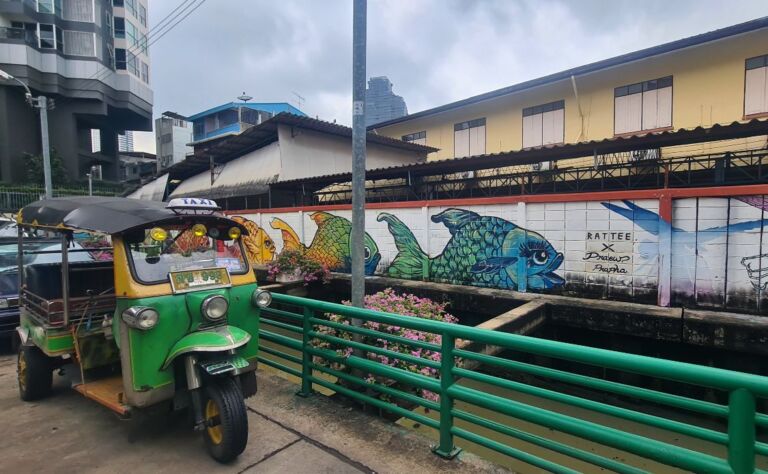Bangkok Bus Guide: Routes & Tips for Adventurous Travellers [2025]
I created this Bangkok Bus Guide because in my first year of living in Bangkok, I’ve discovered that the city reveals itself differently when you take the bus. While most visitors stick to the BTS and MRT, my moves from Punnawitthi to Ari and now to Rama 3 has taught me that they aren’t just a budget option – they’re sometimes the smarter choice.
Yes, the BTS and MRT are faster and more predictable. But when I moved to Rama 3, I discovered something interesting: buses often make more sense. Take the air-conditioned 75 that runs along Narathiwat Road – it’s not just cheaper than a taxi stuck in Sathorn traffic, it’s frequently faster. Plus, you get to watch the city unfold through the window instead of staring at underground concrete.
This page contains affiliate links. Please see our disclosure policy for more details.
Understanding Bangkok’s Bus System
Bangkok’s bus system offers four main types of service, each with its own character:
The BRT runs on dedicated lanes from Sathorn to Rama 3. While limited in reach, it’s Bangkok’s experiment with modern transit, and living along the route, I’ve found it surprisingly reliable. My daily commute to Chong Nonsi takes just 10 minutes – it’s a small glimpse of what Bangkok’s bus future could be.
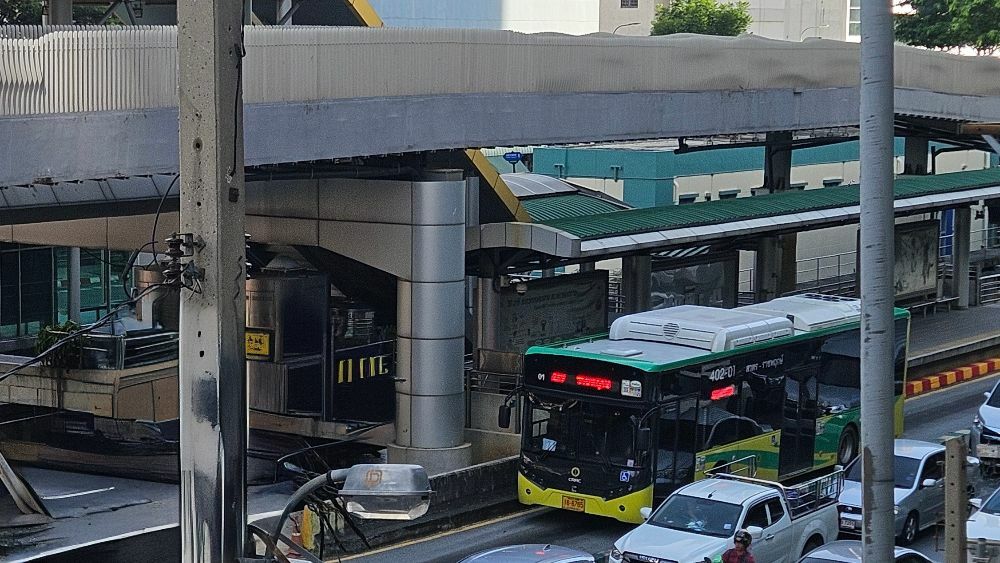
Air-conditioned buses are the yellow or orange workhorses I rely on most. During my time in Punnawithi, the 45 bus became my Sukhumvit alternative – yes, slower than the BTS, but at 13-24 baht, I saved enough for a daily coffee and could hop off midway between stations, perfect on steaming hot days where any extra walking is too much! These are my go-to for cross-city trips.
Fan buses, with their rainbow colours and open windows, are Bangkok’s old guard. They’re not pretty, but at 8 baht, they’re perfect for short hops. During cool season (November-January), I actually prefer these to the arctic chill of air-con buses – plus, you get a better feel for the city’s energy. You might want to wear a mask to avoid breathing in all the exhaust though!
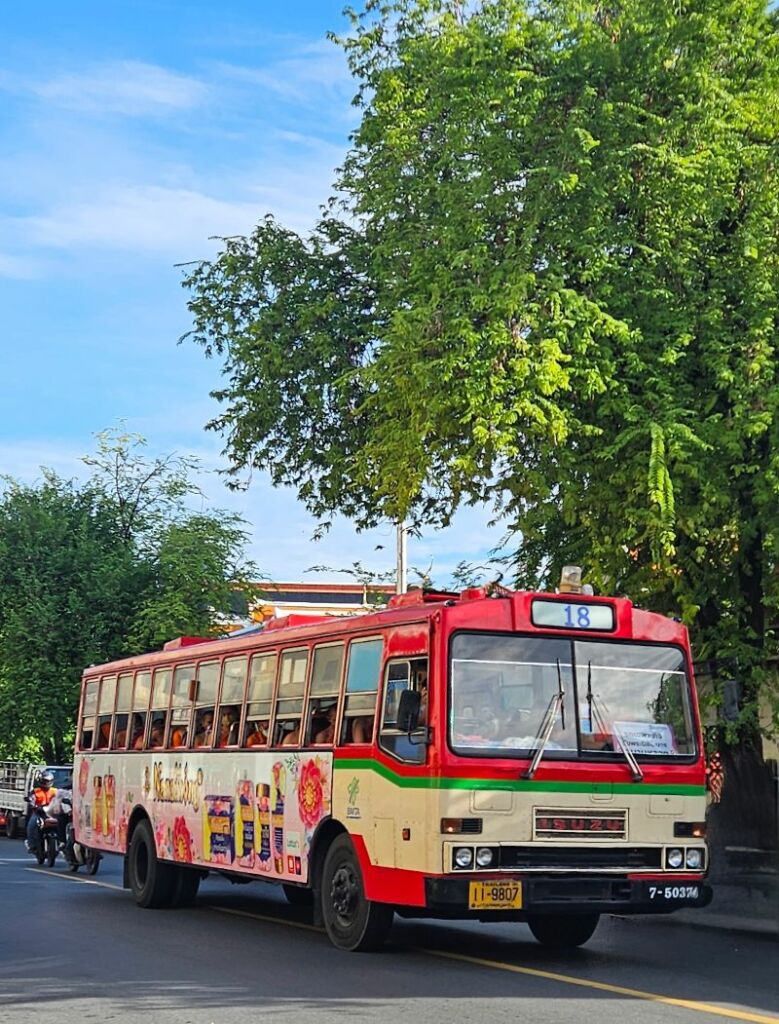
Thai Smile Electric buses bring a touch of modern comfort to the system.Their easy to spot with shiny dark blue paintwork. Lower floors make them easier to board and the Thai Smil Bus (TSB) app lets me track arrival times (though I’ve learned to add a few minutes to their estimates). Look for route numbers starting with “Z” or formats like “1-39” – these mark Thai Smile services.
When to Take the Bus (And When Not To)
Living in different parts of Bangkok has taught me when buses shine – and when they don’t. From Punnawithi, I often took the BTS, but after moving to Ari, I found myself using them more frequently. Here’s why:
Buses excel at cross-neighbourhood trips where the BTS or MRT would require multiple transfers.
For example, getting from Ari to the Chinatown area by train means changing at from the BTS to the MRT. The bus route travels via Khao San Road, so while it might take longer but it’s direct, and you can hop off anywhere along the way.
Early mornings are golden. Before 7am, buses zip through streets that will gridlock later. I’ve made it from Rama 3 to Silom faster than friends taking taxis. The BRT buses have their own lanes so the whole traffic problem is removed.
The trade-off is predictability. But if you’re not in a rush and want to actually see the city while saving money, buses open up Bangkok in ways the BTS never can.
Getting Started with Bangkok Buses
My first Bangkok bus journey taught me everything I needed to know about the system. Fresh off the BTS at Mo Chit, heading to MOCA (Museum of Contemporary Art) one of my favourite galleries in the city, I watched several buses zoom past before realising my mistake – you need to signal for them to stop. A kind local not only pointed out the right bus but showed me the actual stop, a good 100 meters from where Google Maps claimed it should be.
That MOCA trip revealed why buses matter: while technically “near” Mo Chit BTS, the museum sits in that awkward zone too far to walk, too expensive for Grab. The bus drops you right there for just a few baht – if you can handle a few surprises along the way.
Here’s what that first journey taught me:
- Trust the locals, not your phone: Watch where people actually wait for buses. At Mo Chit, the real stop was nowhere near the marked Google location. Now I look for the clusters of waiting passengers instead of official signs.
- Carry small bills: My attempt to pay a 13 baht fare with a 100 baht note earned me a look I’ll never forget. These days, I always break bills at 7-Eleven first.
- Hold on tight: Bangkok bus drivers have their own… unique style of driving. That first ride to MOCA gave me a crash course (thankfully not literally) in what I now call “Bangkok bus physics.”
These days, I use apps like ViaBus to track buses in real-time, and I’ve even started using the new Thai Smile electric ones when possible – they’re more comfortable and environmentally friendly. But that first MOCA trip showed me how buses can open up parts of Bangkok that would otherwise be hard to reach.
Beyond the Tourist Areas
After mastering that first MOCA route, I started exploring more of Bangkok by bus.
Buses like the 3/2-37 which takes you from Saphan Khwai to Khao San Road. A trip which would have required several line changes and a decent walk otherwise.
Now in Rama 3, I’ve found buses particularly useful for reaching places like the Chong Nonsi BTS or shopping at Terminal 21 Rama 3. Tomorrow I am trying out a route that will have me at Asok BTS in just 11 stops with a seat the whole way!
Sure, there are days when Bangkok’s traffic makes me wish I’d taken the BTS. But then there are those perfect morning rides when the bus moves smoothly through empty streets, the sun’s rising over the river and you remember why this way of traveling has endured.
Essential Routes Worth Trying
After a year of exploring Bangkok by bus, I’ve discovered some particularly rewarding journeys. While specific numbers change (always check ViaBus or ask locals), here are some connections worth exploring:
- Khao San Road to Chatuchak: Bus 3 or 9 (13-16฿)
- Siam to Chinatown: Bus 73 (11-13฿)
- Khao San Road to MBK: Bus 47 (13฿)
Culture Routes
The MOCA route from Mo Chit was just the beginning. I’ve since discovered several buses that are perfect for gallery hopping:
- Bus 53-35: takes you from Asiatique via Taled Noi, Song Wat Rd, Yaowarat and Sam Yot MRT
- Bus 32 or 44 : Links Wat Pho to the National Gallery, an otherwise long walk from the nearest river pier.
Food Adventures
Some of my best food discoveries came from bus journeys. The routes through Chinatown are especially rewarding around sunset when the street food vendors are setting up. Victory Monument’s famous boat noodle alleys are easily reached by bus, and I’ve found the stops along the way often reveal hidden gems – tiny sois packed with food stalls I’d never have discovered otherwise.
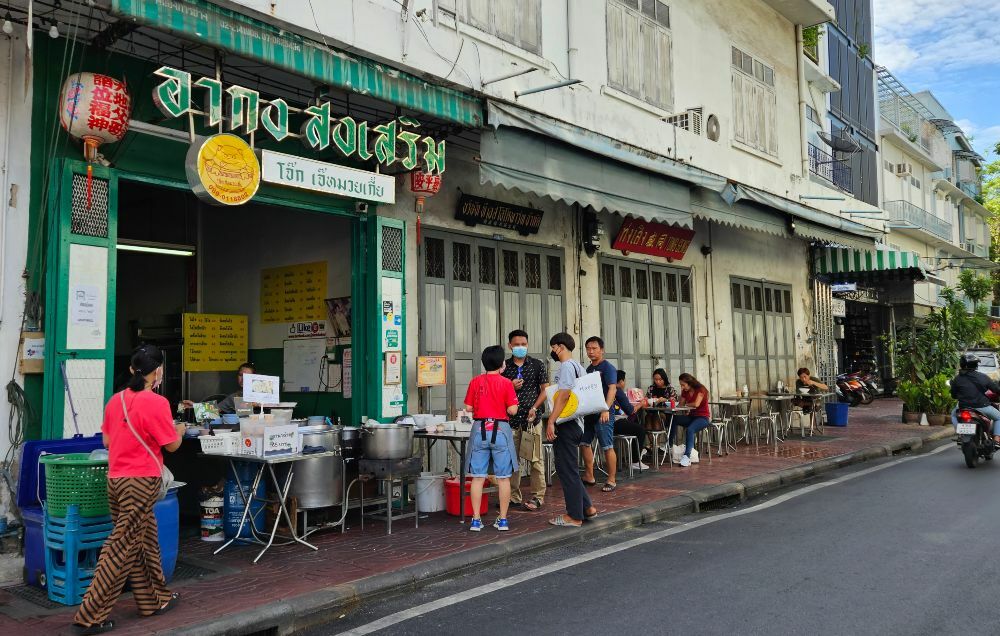
These routes have become my go-to for food exploration:
- Bus 1 (3-35) : Threads through Old Town’s street food havens to Chinatown, Silom and Charoen Krung Road.
- Bus 73: The “Chinatown Express” – great for evening food hunts runs from Siam to Chinatown via local food spot just minutes from Siam, Ban Thatong Road.
Pro Tip: Avoid peak hour trips. While I’ve made it from Rama 3 to Silom in 20 minutes at 7am, the same trip at 6pm can take an hour.
Making Sense of Bus Numbers and Routes
One of the most confusing things about Bangkok’s buses is the numbering system. When I first arrived, I couldn’t understand why some buses had regular numbers like 45 or 75, while others had strange prefixes like Z-11 or 1-39.
Here’s what I’ve figured out: The regular numbers (1-556) are the old system, still used on most buses you’ll see. The newer numbers, starting with Z or having a prefix like 1-39, belong to Thai Smile’s electric fleet. They often show both – for example, “1-39 (71)” means it’s the new electric bus running the old 71 route.
Some useful number patterns I’ve noticed:
- Lower numbers (1-50) usually run through central Bangkok
- Numbers in the 500s often connect to transport hubs
- Even-numbered buses tend to run east-west
- Odd-numbered buses usually run north-south
But honestly? The best way to navigate isn’t by memorising numbers – it’s by using landmarks. When I’m heading to Silom from Rama 3, I don’t look for “Bus 75” – I look for any bus with “Silom” on the front in Thai (สีลม). Taking a photo of your destination written in Thai can be incredibly helpful here.
Timing Your Bus Adventures
The “official” schedule says buses run from 5am to 10pm, but Bangkok has its own ideas about timing. Avoiding buses when you are in a real hurry is probably for the best.
Some survival tips I’ve learned:
- Rush hour (7-9am, 4-7pm) can significantly increase your journey time
- During peak hours, buses often bunch up – if one’s packed, wait 5 minutes for the next
- Night buses exist but are less predictable – I’ve learned to have a backup plan after 10pm
- Weekends run on “Thai time” – especially Sundays when waits can stretch
- Rainy season (May-October) can throw everything off schedule – plan extra time
Local Secret: Want to know if a bus is really coming? Watch the motorcycle taxi guys at the stop. When they start looking down the road, your bus is probably nearby.
Paying Your Fare (Without Irritating the Conductor)
My first few bus rides involved a lot of confused fumbling with change. Now I know better: bus payment in Bangkok is an art form of its own.
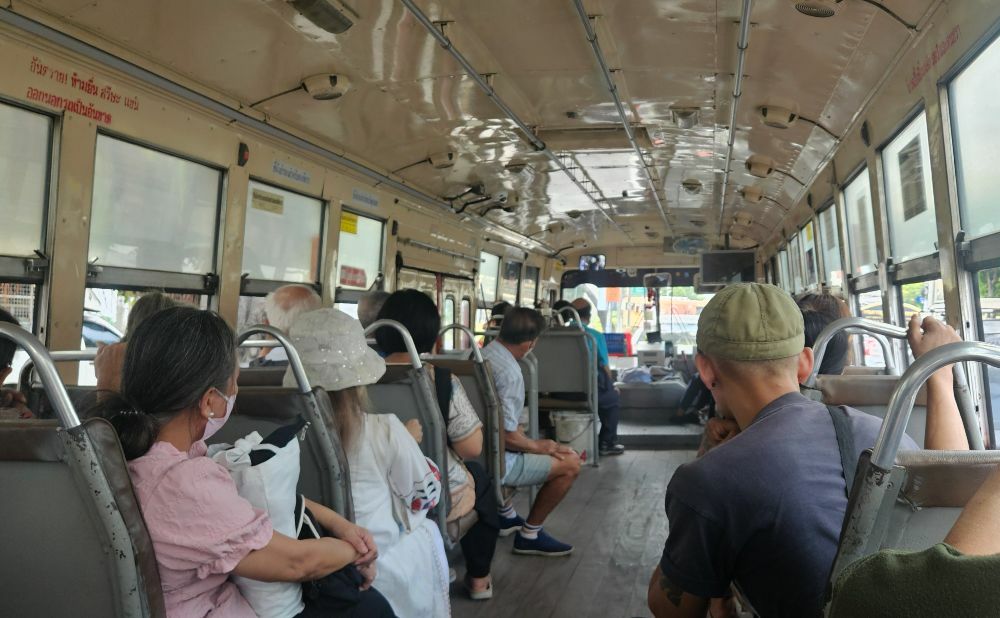
Here’s the scene: You’re on the bus, probably holding onto a handrail tightly (remember that distinctive driving style I mentioned?), when the conductor makes their way to you. On air-con buses, they’ll ask where you’re going – this is when that photo of your destination in Thai comes in handy. On fan buses, they usually just collect a flat 8 baht fare.
Price-wise, here’s what to expect:
- Fan buses: 8 baht flat rate
- Air-con buses: 13-24 baht depending on distance
- Night surcharge: Small surcharge after 10pm
Pro Tip: If you’re planning to use Thai Smile buses regularly, their HOP card is worth considering. It caps your daily spending at 40 baht which can save you money if you’re making multiple trips.
Finding Your Stop (Without Getting Lost)
Getting off at the right stop was my biggest challenge when I started riding Bangkok’s buses. Unlike the BTS, there are no announcements and sometimes even Google Maps doesn’t quite match reality.
Here’s what works for me now: I track my location on Google Maps but also watch for landmarks. When I’m heading to Silom, I know to press the buzzer when I see the golden domes of the Hindu temple. For Siam, the MBK skywalk is my signal.
Some other tricks I’ve learned:
- Sit on the left side of the bus – it’s easier to spot street signs
- Press the buzzer well before your stop – Bangkok bus drivers need advance notice
- If you’re unsure, show the conductor your destination on your phone – they’ll usually signal when it’s time to get off.
Using Apps and Maps (Without Going Crazy)
Technology helps, but I’ve learned not to rely on it completely. Here’s my real-world experience:
Google Maps works best as a location tracker during your ride. Don’t trust its bus stop locations – I’ve waited at phantom stops more times than I care to admit.
ViaBus shines for real-time tracking. Don’t worry if you can’t read Thai, much of the app is in English and the moving bus icons on the map tell you what you need to know.
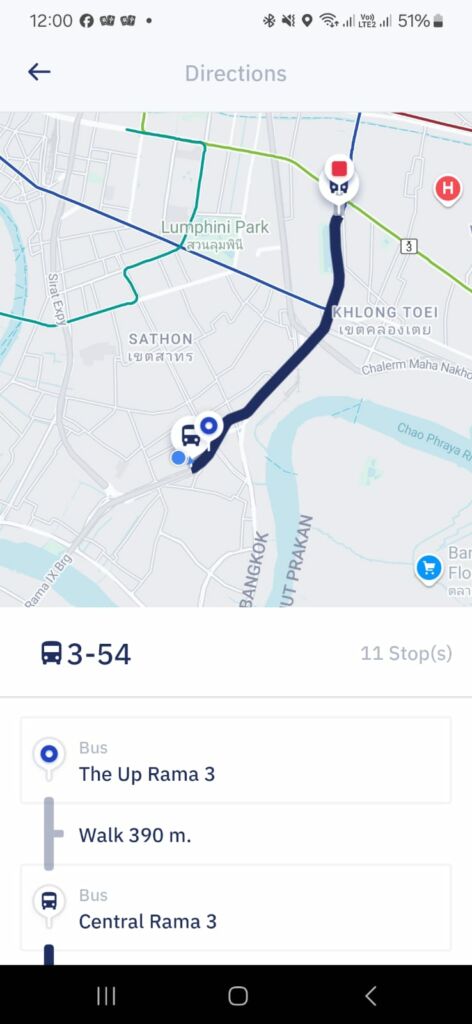
TSB Go makes sense if you’re using Thai Smile buses regularly, mainly for managing your HOP card.
- Screenshot your route beforehand
- Save your destination written in Thai
- Note key landmarks
- Know your return route
It might sound like overkill, but that one time your phone dies in 35-degree heat, you’ll be glad you did.
Reading Bus Signs and Stops
A dead phone during one journey forced me to learn Bangkok’s bus stops the old-school way. Each stop is more informative than you might think: you’ll find route numbers, a destination finder showing where buses go, and even a basic map of the surrounding area.
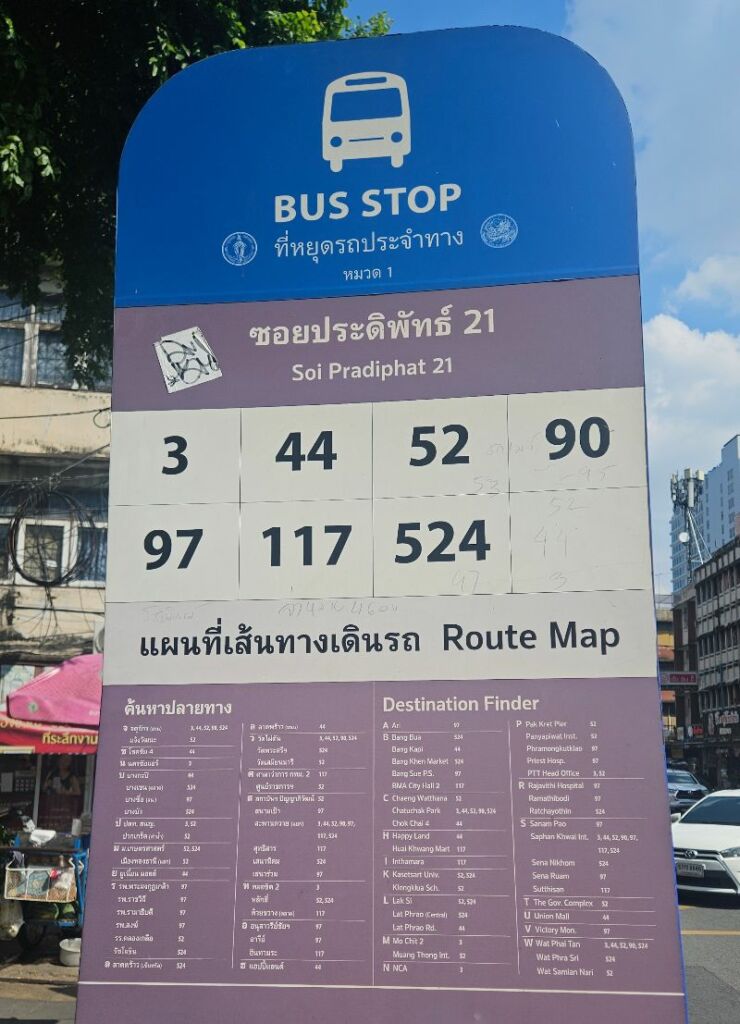
The destination boards on the buses themselves are usually in both English and Thai, making navigation much easier than I first expected. Still, I’ve found it helpful to recognise some common Thai destinations.
Digital vs Reality While some downtown stops now have fancy digital displays showing arrival times, they’re about as reliable as a weather forecast during rainy season. Instead, I watch what locals do – if they start gathering at a certain spot or checking down the road, a bus is probably coming.
Tips for Catching Your Bus
The actual process of catching a bus in Bangkok is straightforward once you know the unwritten rules:
- Stand where you see others waiting, not necessarily at the marked stop
- Signal clearly by raising your hand when you see your bus
- Board quickly – Bangkok bus drivers rarely make full stops
- Have your small bills ready before boarding
- Move to the back if you can – it makes boarding easier for others
Final Thoughts
After a year of exploring Bangkok by bus, I’ve come to appreciate this often-overlooked part of the city’s transit system. Yes, there are days when I’m stuck in traffic wishing I’d taken the BTS. But then there are those perfect moments – watching sunrise over the Chao Phraya from a fan bus, discovering a hidden market I’d never have found underground, or chatting with a friendly conductor who remembers my stop.

Buses might not be the fastest way around Bangkok, but they’ve shown me a side of the city I’d have missed otherwise. They’ve taught me patience, given me countless stories, and saved me enough money for countless mango sticky rice stops.
If you’re willing to trade some predictability for adventure, Bangkok’s buses might just become your favourite way to explore this amazing city.
Remember: keep small change handy, hold on tight, and don’t be afraid to ask for help. Bangkok’s bus network might seem daunting at first, but it’s also one of the most rewarding ways to experience the real Bangkok.
➡️ Planning your first visit? Here’s our beginners guide to Bangkok Public Transport
➡️ Just landed? Here’s our detailed airport transport guide
➡️ Need to change airports? Here’s our transfer guide
➡️ Ready to tackle the trains? Check our complete BTS & MRT Guide
➡️ Interested in river travel? See our Bangkok by boat guide
Planning a Thai adventure? Join our friendly Facebook community Thailand Awaits: Trip Planning for Beginners. Get expert advice from locals and experienced travellers, ask your questions, and discover how to make the most of your journey through Thailand.

